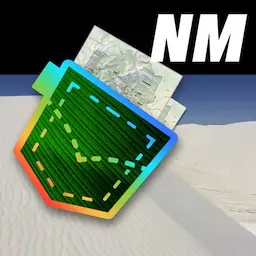"Cloudy afternoon sky at Aztec Ruins" by U.S. National Park Service , public domain
Echoes from the PastAztec Ruins |
featured in
| National Parks Pocket Maps |  | |
| New Mexico Pocket Maps |  |
Aztec Ruins
National Park Service
U.S. Department of the Interior
National Monument
Echoes from the Past
Ancient Traditions
The traditions of the modern Pueblo people have been practiced for over a
thousand years. The songs and ceremonies of ancient times survive through their
continued practice and the oral history of the people.
Music is one of the only traditions shared by all cultures around the world, and
it was certainly a central part of ancestral Pueblo society. Archeological sites
across the Southwest, from Great Houses to pit structures, reveal the extensive
collection of instruments that defined ancestral Pueblo music.
Bells, Shells, and
Trumpets
Some instruments found in sites like Aztec
Ruins were items for which the ancestral
Pueblo people had to trade. They obtained
shells and copper bells through their trade
networks.
Copper bells came from what is now
Mexico. These bells are still used today and
have been used as clothing adornments that
jingle as the dancers move.
worn on bandoliers or sashes across the chest
to make sound as the dancer moves.
Much larger shells were used as shell
trumpets. These murex shells originated from
the Gulf of California. One of these
instruments can be heard from miles away!
Conus shells, used as tinklers, came from
what is now California. Like the bells, these
tinklers have been attached to clothing and
Rasps and Rattles
Not all instruments came from trade.
Many were made from materials readily
available to the ancestral Pueblo.
Rasps are typically made of bone. For
these instruments, an unmodified stick or
bone is rubbed across a notched bone to
produce a sound.
to the Four Corners region, were made of
clay. Clay rattles in particular were usually
mugs or ladles with hollow compartments
that contained small pellets of clay or stone
(photo below).
Most rattles were made of hollowed out
gourd, filled with seeds or small pebbles.
Other rattles, generally confined
Whistles and Flutes
Bone whistles are perhaps the most common
musical instrument found in archeological
sites throughout the southwest. This
instrument is capable of only one or two
tones and may have been used to imitate bird
calls for either hunting or ceremonial
purposes.
Flutes, in contrast with the limited tone
production of whistles, are capable of
producing three or more tones. Most of the
flutes found were made of wood and reed,
while only a few were made of bone.
Drums
Though drums are prominent in modern
Pueblo society, there have been no drums
recognized in the archeological record of the
ancestral Pueblo culture of Aztec Ruins
National Monument. A few explanations
exist for this phenomenon.
Another theory claiming the existence of
drums in this culture is the use of the Great
Kiva vaults as foot drums. This is probably
the most widely accepted theory, with
evidence from both archeology and oral
tradition of the descendents of the ancestral
Pueblos.
Drums of the past may have been constructed
in a way that we cannot recognize them as
such today. Examples of such drums might
be ones made of ceramic, basketry, or gourds.
Over time, the membrane of the drum would
deteriorate, leaving behind what seems to be
a pot, basket, or gourd fragment.
Voice
A commonly overlooked instrument is the
voice. The human body is capable of creating
hundreds of sounds, so it makes sense that
cultures around the world make use of this
talent while creating music.
While the voice cannot be left behind as an
archeological artifact, it is acknowledged that
this musical instrument was well used since
the earliest dates of human existence.
From Past to Present
Many of the instruments from ages ago are
still used today in the ceremonies and songs
of the modern Pueblo people. Pueblos
throughout New Mexico as well as Hopi in
Arizona are open to public visitation during
the year.
The modern Pueblo people have hundreds,
if not thousands, of songs for almost every
aspect of life. For corn grinding alone, the
Pueblo have over one hundred songs.
Like their descendents, the ancestral Pueblo
people used the human voice as an
expression of their sacred songs and
ceremonial prayers.
Some also welcome outsiders for special feast
days, which are a unique blend of
modern (sometimes Catholic) and ancient
traditions. If you visit on a feast day, you will
hear instruments that may be very similar to
the ones used in ancient times. You will hear
echoes from the past.
The Modern Pueblo People
EXPERIENCE YOUR AMERICA


